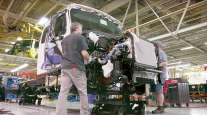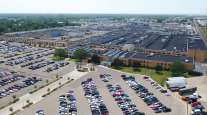Executive Editor
DTNA’s John O’Leary Says Infrastructure Challenges Slowing EV Expansion

[Stay on top of transportation news: Get TTNews in your inbox.]
LAS VEGAS – Daimler Truck North America CEO John O’Leary said charging infrastructure is the key issue limiting further expansion of electric vehicle growth in the trucking industry, and believes his company could be selling more EVs if infrastructure build-out was easier and happening more rapidly.
“Electrification interest is there, but is currently constrained by infrastructure challenges,” O’Leary said during a Jan. 31 briefing with North American trucking media in advance of the Manifest conference. “These continue to be the challenges most limiting to deployment of more units.”
O’Leary noted that customers who have taken delivery of small numbers of the company’s all-electric Class 8 Freightliner eCascadias have expressed interest in adding more, only to realize “they don’t have a way to charge them. That infrastructure is really a limiting factor right now.”
One key reason, he noted, is the time and effort involved in building a charging site.
“Siting, permitting, construction delays — all that has current lead times that is measured in years, not weeks or months,” he said. “There is a lot of will in the regulatory arenas to make that happen, but as we all know when you start talking about moving large, megawatt lines of electricity around, building new substations and things like that, it takes time.”

High and perhaps unrealistic expectations being set by lawmakers also may be clouding the narrative around infrastructure buildout, O’Leary noted.
“The general public thinks that because all of the politicians and regulators are saying all of these grandiose things — we need to do this and it’s going to happen, and passing rules and regulations — that doesn’t get dirt turned by shovels, and electric power generated and substations built. That’s the longer-term problem,” he said.
O’Leary noted that DTNA has dedicated resources to helping fleets with these challenges.
“We do have an internal consulting group that is specializing on infrastructure, and helping customers understand what it takes to get permits, what it takes to find a construction company that is able to do that,” he said. “We’re working very closely with them.”
The truck maker is also working closely with dealers to prepare their shops for servicing electric trucks, O’Leary noted.
“In terms of training service techs — it’s not just how to fix it, [but] how to operate and fix them in a safe fashion, because you are dealing with voltage that is extremely dangerous,” he said. “There is a whole safety protocol in training that has to be followed, so we have been working for well over a year to get our service network trained up. We have also been doing a lot of work to get parts into the [parts distribution centers] so that we will be ready when the demand for those starts happening. But, as of right now, it’s still pretty early days.”
On that last point, O’Leary stressed that it’s too soon to comment on trouble areas carriers are encountering with electric trucks.

Freightliner unveiled its production-ready eCascadia Class 8 electric truck on May 10, 2022, at ACT Expo in Long Beach, Calif. (Daimler Truck North America)
“It’s too early to really say what exactly they are experiencing — what are they actually struggling with — but I would say this: we have put a huge amount of work into preparing for that,” he said.
O’Leary also stressed that while an all-electric unit obviously differs from a diesel-powered truck, DTNA’s strategy of building EVs from existing Freightliner models ensures some familiarity.
“It’s a Cascadia, and an m2,” he said. “The powertrain is different, but the rest of the truck is tried-and-true. Everyone knows what they’re working on there. If you have an interior issue or seat issue, it’s not something that has just been invented by some startup company. It’s something that’s in service today. That’s something that, we think, simplifies it radically.”

Host Seth Clevenger speaks with Torc Robotics CEO Peter Vaughan Schmidt about the realities of autonomous truck technology and how they fit into the freight transportation industry. Hear the program above and at RoadSigns.TTNews.com.
Second of a three-part series on autonomous vehicles. Hear Part I here. Part III coming Feb. 2.
It’s this kind of preparation and planning that O’Leary hopes will coalesce around build-out of more charging infrastructure to help propel the electric market, as he believes DTNA could be selling more EVs now.
“We have the capacity to produce 2,000 right now, and that will continue to grow over time,” he said of annual output capacity. “We are in the process of building out that capacity because we know at some point that will be required.” DTNA ramped up to produce that many, O’Leary noted, based on conversations with customers. But then, he said, customers changed course in the face of the charging challenges.
“I know I told you I wanted 200 in 2023, but how about I take 25 and push the rest out until later,” he said was a sample comment from customers. “It’s great that the acceptance has been so strong — the people who have them love them — they just need to figure out how to charge them.”
Want more news? Listen to today's daily briefing below or go here for more info:




